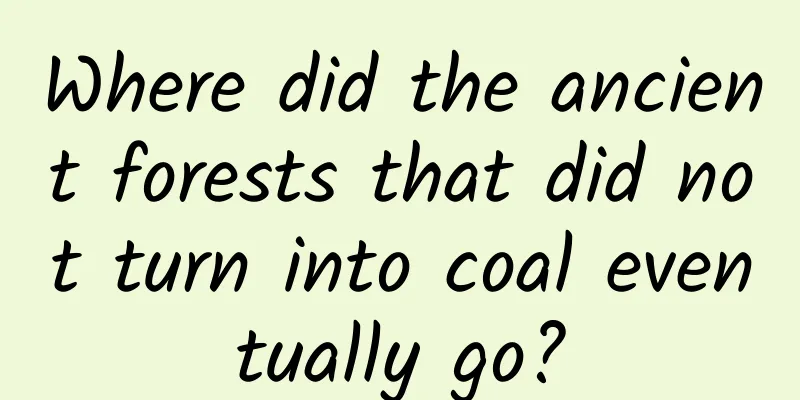Where did the ancient forests that did not turn into coal eventually go?

|
In the heavy rain, a group of Placerias slowly walked out of the Araucaria forest on the river bank, touching the soft, low-hanging branches with their bodies. The first one on the left is Placerias hesternus. The Rainbow Museum, a small museum in the visitor center of the Petrified Forest National Park, displays many animal fossils from the same stratum as the Petrified Forest. The three species in the picture look like dinosaurs, but they are not. They are much earlier than most dinosaurs. Placerias hesternus belongs to therapsids and is more closely related to mammals. The one in the middle is Postosuchus kirkpatricki, a predator under the archosaur-pseudosuchian, and the one on the far right is Desmatosuchus, a herbivorous crocodile. | Uncle Zhong These hippo-sized animals carefully walked across the riverbed in search of food. This lowland river swamp was full of the ferns they loved - there were also many huge horsetails near the edge of the forest, but the stems of horsetails were filled with rough silica, making them difficult for them to swallow. The flat-footed crocodile used its turtle-like beak to tear off large fronds of ferns, then raised its head alertly to chew. The river was often roamed by the 10-meter-long, terrifying scissor-toothed crocodiles (Smilosuchus), which were terrifying predators in the swamps of the late Triassic. This skull is from the genus Chiselosteus; although it looks like a crocodile, it is a predator in the order Phytosauria and is very distantly related to crocodiles | Uncle Zhong But suddenly, the muddy river water flooded over a large clump of ferns in front of the flat-necked beast, the sound of large trees being uprooted came from far away, and the strong wind whistled through every tree in the riverside forest. Before the flat-necked beast could even make a sound, the flood caused by the heavy rain came all over the sky, and the swamp seemed to be overturned. Every chisel-toothed crocodile and flat-necked beast was wrapped in trees and mud and rolled around, unable to make any sound. It took several months for the flood to slowly recede. Except for some treetops sticking out of the mud, a thick layer of mud buried most of the life in this small swamp. The world is far from what it is today This was a small-scale flood that occurred 225 million years ago during the Norian period of the late Triassic period. More than 20 million years have passed since the end-Permian extinction event, the largest extinction event in the history of multicellular life on Earth, and life has long since flourished again. Animals and plants had already landed on land 200 million years ago, and some plants evolved lignin that can be used for transport and support. They are moving inland at an unprecedented speed. The spectacular lycopod and horsetail rainforests of the Carboniferous period collapsed 80 million years ago, and the coastal forests are full of ancient relatives of today's gymnosperms, with appearances similar to cycads, ginkgo, araucaria, and conifers. Flowering angiosperms are still hard to find. Imaging of a swamp forest during the Late Triassic period | Blue Mesa Room, Rainbow Forest Museu / NPS At this point in time, the world was far from what it is today. The crust beneath our feet is not a monolithic entity. Large land masses have been separated and reunited in geological history. In the late Paleozoic era more than 300 million years ago, a supercontinent was re-formed on the earth, called "Pangaea". The name "Pangaea" was created by Alfred Wegener, who proposed the theory of continental drift. It comes from the combination of "pan (all)" and "gaea", the latter referring to "Gaia, the mother of the earth". Pangaea, about 200 million years ago | Fama Clamosa / Wikimedia Commons The flood occurred in Arizona, which is located in the western interior of the United States today, but 225 million years ago, it was in the tropics, on the southwest coast of Pangaea, facing the predecessor of the ancient Pacific Ocean, one of the largest oceans ever on Earth - Panthalassa. The huge thermal difference between land and sea caused frequent rainfall in Arizona during the Triassic period. Tropical precipitation nourished a large area of swamp forests and fauna, but often destroyed them with floods, which left a significant mark on the strata: floods constantly carried mud, debris and buried lives, deposited in low-lying basins; millions of years later, the thickest sedimentary layer found today is more than 500 meters. In addition to floods, large-scale volcanic activities are also not uncommon, and swamp forests often thrive in the cracks between flood mud and volcanic ash. The ancient forest was buried by a mudslide or a volcanic eruption. After hundreds of millions of years of sedimentation, it was exposed to the surface again due to geological uplift and erosion by wind and water. The same effect also formed the rainbow-like stratigraphic structure. The sunset and evening storms gave the rainbow-like stratigraphic structure even more unpredictable colors. | Uncle Zhong However, the buried lives did not disappear completely, and another spectacle continued in the details, which is why we can get a glimpse of the appearance of life on the North American continent at the end of the Triassic period today. The microscopic miracle of stealing The trees surrounded by mud and volcanic ash are completely cut off from the air; the abundant rainfall fills the wood, creating an oxygen-deficient environment. This makes it difficult for fungi that decompose wood to survive, further slowing down the degradation rate. The tiny amount of silica dissolved in the water combines with lignin molecules through hydrogen bonds over a long period of time, and gradually deposits around the wood again in crystals or amorphous forms, completely replicating the shape of the wood like a mold. The wood itself breaks down and degrades over a long period of time. Silently, various forms of silica minerals such as quartz and opal completely replaced wood, and occasionally other impurities were mixed in, forming minerals similar to agate, while the form of wood was preserved in this microscopic substitution. They formed the form of tree fossils, that is, petrified wood. Under similar effects, the structure of some animal remains was also replaced and preserved by minerals, becoming fossils. Most of the petrified wood in the petrified forest comes from extinct gymnosperms such as Araucarioxylon arizonicum, which is similar in morphology to today's Araucaria | Zhong Shushu Some cross-sections show the iridescence of agate and opal | Uncle Zhong Over millions of years, the sediments brought by floods covered this place layer by layer. These sediments have different compositions and textures, such as quartz gravel, calcium-containing chalk, oxidized iron-containing red soil... They are precipitated like pages of a book. If the geology is stable for a long time, the lower sediments will be pressed by the upper layers, and they will become sedimentary rocks. The vast Pangaea continent began its last split and disintegration in the Jurassic period 180 million years ago, and the North American continent was also pushed away from the tropics by plate movement. Hundreds of millions of years later, under the compression of the Pacific Plate, this large area began to rise from the shallow sea. From 60 million years ago to today, the altitude of some areas is even more than 3,000 meters - this is now the Colorado Plateau. The original swamps have completely disappeared, and the humid coast has become arid inland. Petrified wood can be up to 30-40 meters long, with a diameter of more than 1 meter, and can be found everywhere | Uncle Zhong During this process, the previously unstable sedimentary belt was eroded and weathered by flowing water and strong winds, forming thousands of gullies and colorful mounds. The beautiful petrified wood and animal fossils were also exposed to the wilderness again and discovered by humans who arrived here thousands of years ago. The process of forest burial has occurred in many geological periods around the world. Today, petrified wood has been unearthed in almost every continent, from the deserts of North America to the plains of Central Europe, from the Junggar Basin in Xinjiang to the coast of Madagascar in Africa; the strata in which it is located range from the Permian period of the Paleozoic Era more than 300 million years ago to the late Tertiary period of the Cenozoic Era 2 million years ago. The rapid burial of floods and volcanoes and the silica-rich water bodies created this process that is completely different from coal formation and decomposition by fungi, giving the dead forest another kind of vitality. Shenzhen Xianhu Botanical Garden has a "fossil forest" that collects petrified wood from Liaoning, Xinjiang, Inner Mongolia and even North America in China, which is enough for citizens to meditate on the dramatic changes in mountains and seas when visiting. These petrified woods are often covered with bright yellow lichens, which secrete organic acids such as oxalic acid, which can erode rocks more strongly. The last remains of this forest will not be able to escape weathering and will become soil, eventually returning to the Earth's material cycle. | Uncle Zhong When I drove across the Colorado Plateau, I saw nothing but rocks and desert. Without these petrified wood and spectacular sedimentary layers, who would have known that there was once a continuous coniferous forest here? Who would have known the fate of a group of flat-footed beasts? Walking in the remains of the forest, I saw some thorny plants with bright yellow flowers growing on the jade-like forest fragments. They were probably Opuntia polyacantha of the Cactaceae family. Their juicy stems and sharp thorns are adapted to the arid climate. There were also some ephedra and Purshia of the Rosaceae family. The ancestors of these plants arrived here no more than 10 million years ago. Two hundred million years after the Triassic swamp forest disappeared, life on this land took on a new look. Next to the petrified wood fossils that died in the Triassic period, cacti and antelope plums have bloomed. The vegetation has completely changed | Uncle Zhong Standing by this former forest, I couldn't help but imagine: If the ancestors of the Eastern Jin Dynasty had seen such wilderness and "silicified forest", I wonder what other idioms would they have invented besides "the sea changes so much"? The vastness of geological history requires wild imagination. Did the people who first encountered petrified wood also fall into emptiness and confusion? But when I saw the rock paintings on those stones, I believed that these stories had decorated human dreams tens of thousands of years ago. Rock paintings left by Native Americans in Petrified Forest National Park | VIP Stuart Holmes / NPS This article comes from the Species Calendar, welcome to forward If you need to reprint, please contact [email protected] |
<<: Liu Feng丨Like humans, airplanes also get tired
>>: What are the steamed buns that Wu Dalang sells, and how much are they worth?
Recommend
Fixed traffic scale, using ecpm formula to improve advertising monetization capabilities
According to the concept of eCPPM, given a fixed ...
Get these six points right, attracting seed users won’t be a problem (Part 1)
Probably, the first and most important operationa...
What is the lunar calendar date for Spring Festival 2022? What specific day is it? Is it March 21st?
There are many customs that have been passed down...
Google now releases the second beta version of the Android 14 system developer preview
On March 9, Google released the first developer p...
Internet celebrity brands seek change and fight back!
As the year 2021 is about to pass, the new consum...
Setting benchmarks, segmenting, review of Tik Tok content marketing in 2018!
In the blink of an eye, the mobile Internet has b...
"Trimming horse hooves, washing carpets, squeezing blackheads..." Why can't you stop watching these videos?
Produced by: Science Popularization China Author:...
UNEP: Emissions Gap Report 2022
Since the 26th United Nations Climate Change Conf...
Volvo's first pure electric car will be put into production in China and exported to the global market
According to Automotive News Europe, an informed ...
Attention! Do not take these medicines with fruits!
Review expert: Wang Xuejiang, professor at Capita...
What is the TAG tag? How to use the TAG tag correctly?
For many staff who have just engaged in network p...
How should Xiaohongshu be operated to increase followers?
The diversity of new media platforms has made it ...
Why do small and medium-sized enterprises and self-employed individuals need to apply for Douyin Blue V certification?
Why do small and medium-sized enterprises and sel...
Cancer is not scary. If you do these three things, you can "live with cancer". Please save this article.
With the advancement of modern medical technology...









